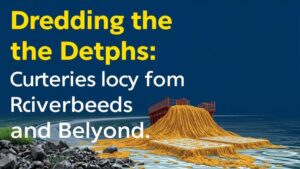Hidden Fossil Beds: Discovering Prehistoric Plants and Animals in Stone Layers
Hidden Fossil Beds: Discovering Prehistoric Plants and Animals in Stone Layers
For rockhounds and mineral collectors, the thrill of discovery goes beyond the shimmering minerals and stunning rock formations. Beneath the Earths surface lies a rich tapestry of history, encapsulated in hidden fossil beds. These fossil beds are invaluable for understanding prehistoric life, and they offer collectors a unique opportunity to connect with the Earths geological past.
The Science Behind Fossilization
Fossilization is a complex process by which organic material is preserved in sedimentary rock. This can occur through several methods, including:
- Permineralization: This occurs when minerals dissolved in water precipitate into the spaces within organic material. An example is petrified wood, where the original wood structure is replaced by minerals like silica.
- Cast and Mold Fossils: When an organism leaves an imprint in sediment, that mold can be filled with minerals to create a cast, preserving its shape.
- Intact Preservation: This happens in rare instances when organisms like insects become trapped in amber or ice, preserving them almost perfectly.
Each of these processes provides different insight into prehistoric life and the environments in which these organisms lived, allowing scientists and collectors alike to piece together the history of our planet.
Identifying Fossil Beds
Finding hidden fossil beds requires knowledge and exploration. The following geological settings are often promising:
- Riverbanks and Sandbars: Erosion from water bodies frequently uncovers fossils, providing easy access for collectors.
- Cliffs and Exposed Rock Outcrops: Areas where sedimentary rock layers are visible can reveal rich fossil deposits.
- Quarries and Roadcuts: Commercial sites often expose layers of stone where fossil beds can be located.
Utilizing geological maps and databases, such as the United States Geological Survey (USGS), can guide collectors to promising sites. It is essential to respect private land boundaries and obtain permission when necessary.
Noteworthy Fossil Beds Around the World
Certain fossil beds are renowned for their biodiversity and the quality of specimens found. Here are a few notable examples:
- Burguillos Fossil Bed, Spain: Known for its rich deposits of marine fossils, including ammonites and belemnites from the Jurassic period.
- La Brea Tar Pits, USA: This site has yielded a wealth of Pleistocene fossils, including those of saber-toothed cats and mammoths, preserved in natural asphalt.
- Green River Formation, USA: Famous for well-preserved fish and plant fossils from the Eocene epoch, showcasing an ancient lake ecosystem.
These sites not only serve academic research but also attract collectors eager to find prehistorical treasures.
Best Practices for Collectors
For rockhounds interested in collecting fossils, the following best practices ensure both ethical enjoyment and preservation of fossil beds:
- Research Historical Context: Understand the significance of the fossils and the geological history of the area you are exploring.
- Use Proper Tools: A basic fossil collecting kit should include tools such as a rock hammer, chisel, and safety goggles.
- Practice Responsible Collecting: Only collect fossils legally and sustainably. Leave large or scientifically valuable specimens for professionals.
Also, maintaining a detailed journal of locations, species found, and the conditions under which they were uncovered proves invaluable for future reference and contributes to personal growth as a collector.
The Role of Technology in Fossil Discovery
Advancements in technology are revolutionizing how fossil beds are discovered and studied. Techniques such as:
- Ground-Penetrating Radar: This non-invasive method allows researchers to identify underground formations without excavation.
- 3D Imaging and Modeling: Digital tools provide a means to analyze and replicate fossils accurately, enhancing their study and preservation.
Utilizing technology not only aids in the discovery of fossil beds but also enhances the way fossils are categorized and studied, leading to a more profound understanding of ancient ecosystems.
Conclusion: Embracing the Past and Future
The allure of hidden fossil beds extends far beyond mere collection; it involves unlocking the mysteries of the Earth’s history. With diligent research, responsible collecting practices, and an appreciation for modern technology, rockhounds can contribute positively to the field of paleontology while also enjoying their passion for fossils. The journey into the geological past is one that promises excitement and discovery, enriching our understanding of life as it once was.
As you embark on your fossil-hunting adventures, remember to respect the land and its history. Each fossil you uncover not only tells a story of the past but also bridges the gap between ancient life and our current understanding of the natural world.



